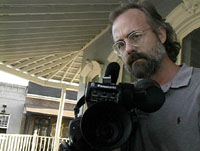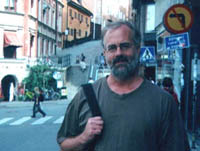
 |
 |
 |
I started taking still photographs when I was ten and within five years I had my own dark room and was learning about light and film emulsions and the zone system for exposure. I didn't discover motion picture film until college and it was like magic when I suddenly saw this whole new dimension that happened when a picture moved. I got into NYU's Grad Film school soon after that, which was an incredible experience. That was thirty years ago. | ||||
Kent Moorhead – with his camera
|
Kent Moorhead in Stockholm
|
|||||
Kent's thoughts about: |
My directing teacher at NYU was Lazlo Benedek, who directed Marlon Brando in The Wild One. My first year teacher was Roberta Hodes, who had been Elia Kazan's script supervisor for On the Waterfront. My camera teacher was Beda Batka, a great cameraman in the 1960's Czech film industry. My writing teacher was Arnaud D'Usseau, a blacklisted Hollywood writer who moved to France and became a playwrite. We had George Cukor, Sam Fuller and John Badham come in and do short courses and a lot of the top directors of the 70's would screen their films at the school theatre, called the Bijou. We really didn't have much good equipment to work with at NYU so you had to learn to be creative with what you had or work with others to share rental costs on things you had to have that the school didn't provide, like editing suites. We learned where all the deals were on film gear in New York – it was a tough way to go to school, but the school attracted really good students, and you were always learning, both from the teachers, but especially from each other. I wouldn't trade the experience for anything. |
|
"Now and then you run into people who think filming is something you just do. They couldn´t be more wrong". Kent Moorhead has an MFA from NYU, seen as one of the top film schools. "You learn from others, but you also learn by trying. Film school pushes you to try a lot of different things." An education doesn't stop when you leave school. Working with some of the best, like famous French director, Bertrand Tavernier and Bob Parrish, one of the great Hollywood editors and director, has taught him one thing above all; to go for the story, We are people and people are what we care about in a story. "In Coffeecakes a la Français" the message was: learn the culture of the country you do business with, or you risk the deal. "But you can't have a person acting that message. You have to come up with a story that it is believable and interesting on a human level. And then let the story come through the characters. In the ad I did for Ole Miss, I wanted to focus on literature, because that's what the place is known for and I found a former student, now a best-selling mystery writer to focus on". Filming the international Pizza competition meant having to be at the right spot, the right time, to capture what happened. "It takes reading the situation and pre-visualizing the shot. I love doing that". In "Pale in your shadow" the challenge was shooting in black and white, which takes a lot more skill. "We also had a crane which meant we could move the camera in so many ways, it was wonderful, But it means it is not enough for the camera to be good, the whole crew has to be good. And it was." When you shoot events, like in the film "Tackling the giant", you gather a lot of material. "And reality is not organized, it is messy". It is in editing that you begin to see the story. The World war II film, was a challenge, because each veteran had a story. But they had to be connected. "I wasn´t looking for time or place, but for what was connecting people, when it comes to experiencing a war." In "Coffee Cakes a la Français, the challenge for me as a director was that some actors were very experienced and some not at all. I had to find out what I could get from each". For Brices Crossroads, which had a lot of recreated scenes, the director had to know the history to know what to look for. "You have to be there intensely, so that when you see that guy on a horse, coming into the frame, you see exactly what is needed for the shot". "Brices Crossroads" contains a long interview with Shelby Foote, a major expert on the Civil War. "That meant I had to know enough about the issue, to ask about the right things. But just as importantly: to know how to ask a question so that I got the full interesting answers that work in a film". "Mississippi Remember World War II", was built on interviews with over twenty veterans. "It was about listening carefully for what hasn't been said, but is there and will come out with the right question. I wanted the story of what happens to people in a war and many had never told that before". The first step is to build a crew that works well together. It starts with the cameraman. "That is who I must intensely communicate with" Kent Moorhead talks at length with those involved on the crew. "After you know you are on the same wavelength, you can and must trust them to do their job." In Radishes and Butter, it all came together; an excellent crew working in sync, made it possible to shoot the whole fifty minute film in four days. |
|